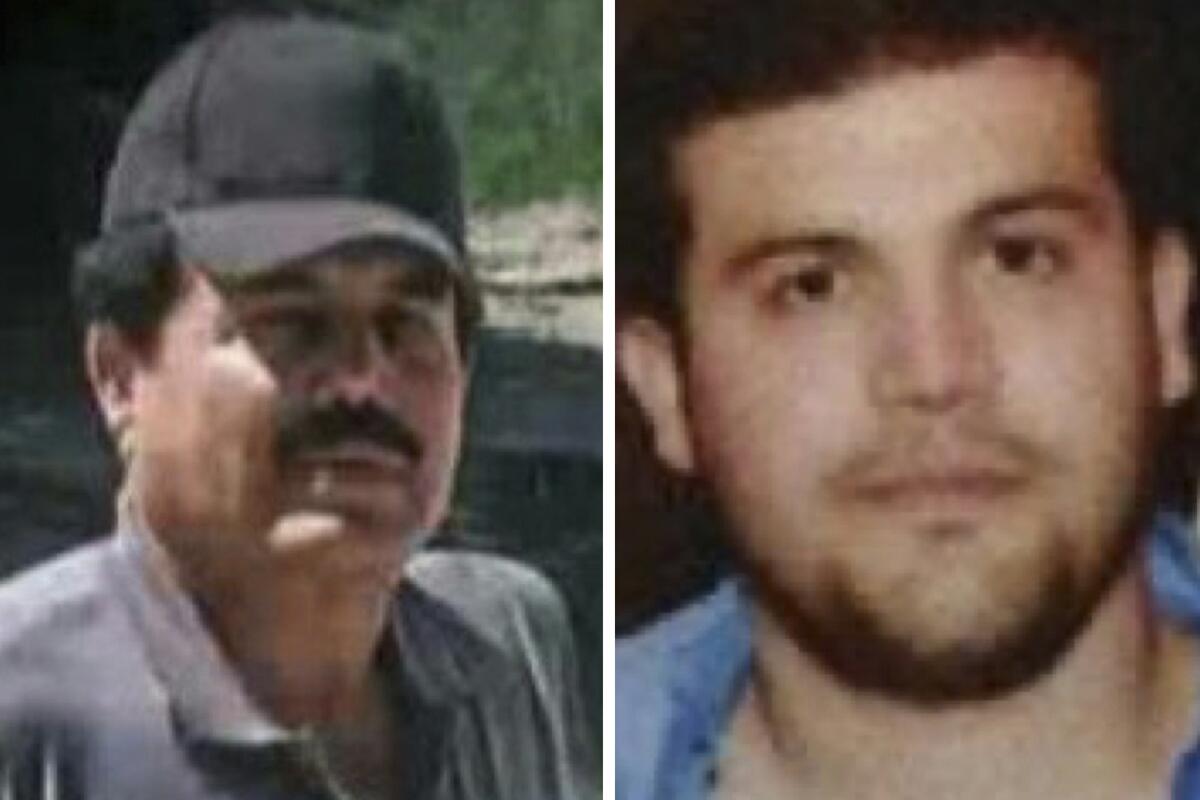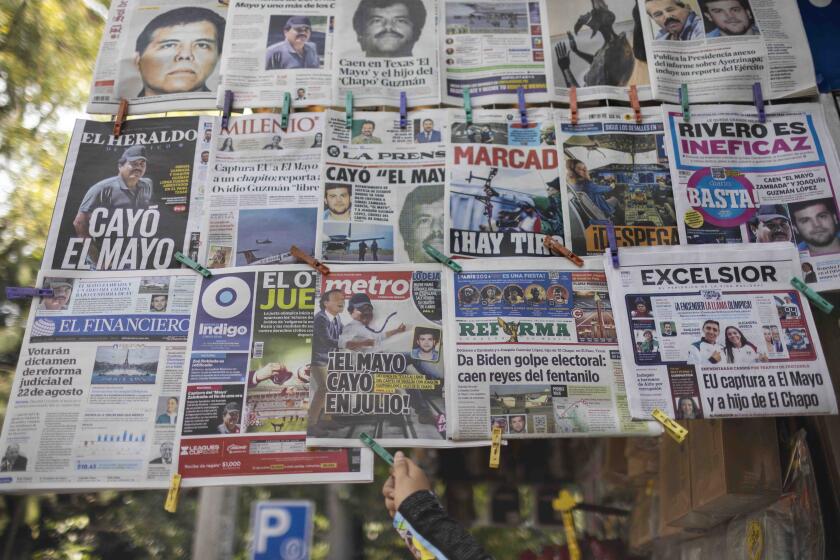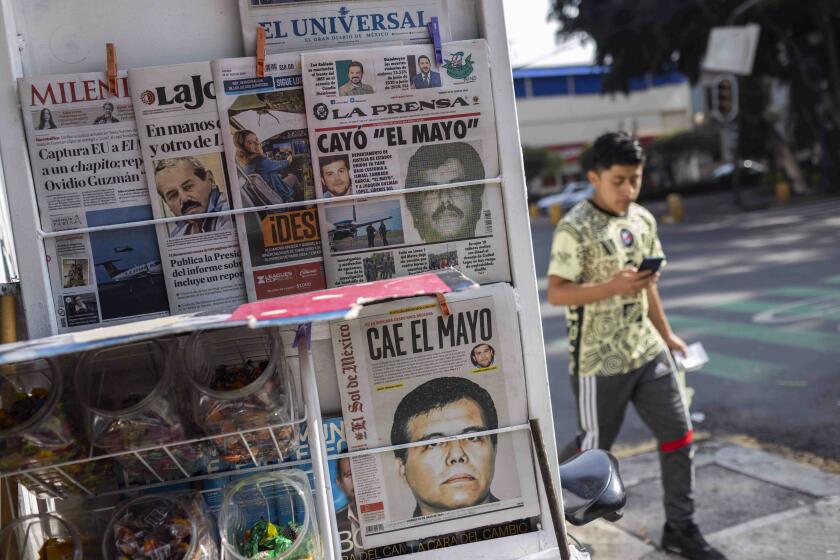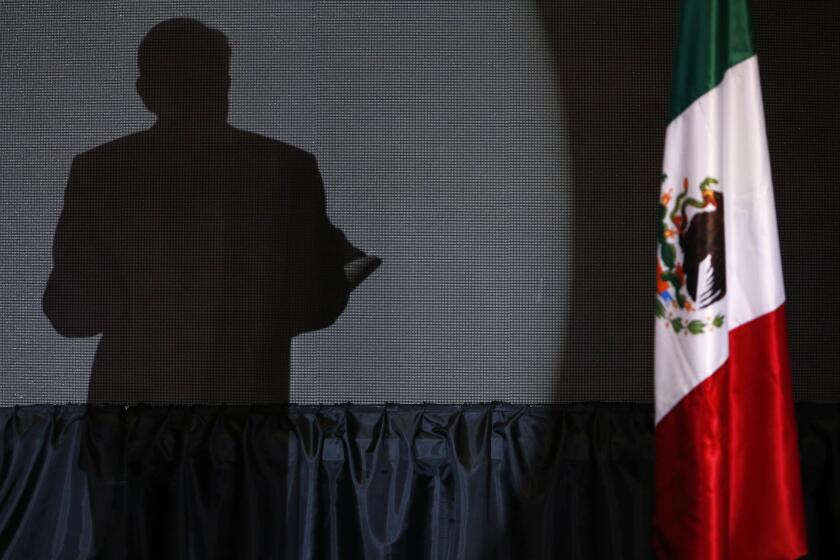Bitter feud among Sinaloa cartel families brings grim new tactic: Grave desecration

- Share via
- As factions of Mexico’s Sinaloa cartel wage war, one side is suspected of desecrating tombs that belong to rival families.
- One recent incident targeted a tomb near Sinaloa’s capital Culiacán said to belong to the family of Ismael “El Mayo” Zambada.
- Two sons of Joaquín “El Chapo” Guzmán are in custody in the United States, with one accused of kidnapping El Mayo
The charred husk of an artificial Christmas tree smoldered in the aftermath of the fire, ashes coating the tiled floor as flames still licked at the scorched ceiling.
The burned structure is the size of a modest living room, and it was built with a similar purpose: A place for loved ones to gather and enjoy each others’ company on holidays or special occasions.
But the edifice is no home — it’s a tomb in Mexico’s Sinaloa state, allegedly targeted for arson earlier this month because it belongs to the family of Ismael “El Mayo” Zambada, reputed co-founder of the country’s most powerful drug cartel.
After decades on the run, Zambada, 78, was arrested by U.S. authorities in July at an airport near El Paso. Since his capture, which he claimed in a letter from jail was orchestrated by a son of his longtime partner, Joaquín “El Chapo” Guzmán, war has erupted among rival cartel factions.
As the cradle of Mexico’s narco culture, Sinaloa has seen its share of horrific violence during cartel feuds of years past. The desecration of tombs, however, is a stark indication of the deep enmity that has developed between El Chapo’s adult sons, known as “Los Chapitos,” and those who cooperated in the U.S. case against their father.
It is customary in Sinaloa — particularly among families of fallen drug traffickers — to construct elaborate tombs to honor the dead. The most ostentatious resemble small churches or even condo-style apartments with air conditioning, TVs and couches where families can comfortably spend time together. Jardines del Humaya, a sprawling cemetery on the outskirts of Sinaloa’s capital, Culiacán, contains several enormous mausoleums, including one made to resemble the Taj Mahal.

At least two desecrations have occurred so far. The most recent involved a Zambada tomb built for one of El Mayo’s grandchildren, said to have died as a 7-year-old boy in an ATV accident. He was the son of Vicente Zambada Niebla, heir apparent to the cartel throne until his 2009 arrest in Mexico City. After he was extradited to the U.S., Zambada Niebla cooperated with federal authorities and served as a key witness during El Chapo’s trial in 2019.
Sources with knowledge of the recent incident, who requested anonymity over concerns of potential retaliation, said men ransacked and torched the Zambada mausoleum located near Culiacán on Jan. 4.
There is growing evidence to suggest Ismael ‘El Mayo’ Zambada was hauled against his will from Mexico to El Paso in an effort by El Chapo’s son to curry favor with U.S. authorities.
Days after the burning of the tomb, the sources said, men returned to inflict more damage and remove the remains of several Zambada relatives.
Zambada Niebla is believed to be under witness protection in the United States. His lawyer, Frank Perez — who also represents El Mayo — declined to comment.
The elder Zambada has pleaded not guilty to an array of federal charges, including for alleged murders, which could carry the death penalty. He appeared before a judge Wednesday, where he told the court he trusted Perez to continue handling his case despite a potential conflict of interest also representing his son, Zambada Niebla, who could be called as a witness if the case goes to trial.
The proceeding was held in the same Brooklyn courthouse where El Chapo was convicted of drug smuggling, money laundering and weapons charges. He is serving a life sentence in U.S. federal prison, and an appeals court denied a last-ditch effort to have his conviction overturned on Jan. 10. Two of his sons remain free in Mexico and are believed to be top cartel leaders. Two others are in U.S. custody.
At a court hearing last week in Chicago, federal prosecutors said Joaquín Guzmán López, 38, and his brother Ovidio, 34, are engaged in plea negotiations for a “global resolution” to multiple pending indictments. Both stand accused of trafficking large shipments of fentanyl and other drugs across the border, fueling a surge in U.S. overdose deaths. Their lawyer did not respond to a request to comment.
After his arrest over the summer, El Mayo claimed that the elder Guzmán López brother lured him to a meeting on the outskirts of Culiacán, then kidnapped him and forced him onto an airplane bound for the U.S., where federal agents were waiting when they landed.
Zambada, a Sinaloa cartel founder, was long believed to have police, soldiers, political leaders in his pocket. In a rare public statement, he acknowledges those ties -- and contradicts Mexican officials’ version of his capture.
El Mayo laid out the allegations in a statement from jail released in August by his lawyer, ending his message by calling for “the people of Sinaloa to use restraint and maintain peace in our state.”
“Nothing can be solved by violence,” El Mayo wrote. “We have been down that road before, and everyone loses.”

Since then, however, gunfights have erupted regularly around Culiacán, with decapitated bodies bearing threatening messages left on public display.
Graveyards have not been totally off-limits in past eras. After he was gunned down in December 2009 by Mexican security forces, Arturo Beltrán Leyva — a drug lord known as “The Boss of Bosses” — was buried in a mausoleum in Jardines del Humaya, the final resting place of many prominent traffickers. Within weeks, a severed head appeared in front of his tomb with a red flower tucked behind the ear, and the remains of a body nearby in a black plastic bag.
Once tight with both El Chapo and El Mayo, Beltrán Leyva and his brothers had been engaged in an all-out war with their former allies. Although Sinaloa has seen intense spasms of violence, most notably in response to government operations to capture El Chapo’s sons, in recent years there had been relative calm under a longstanding but fragile alliance between the Zambadas, Guzmans and other prominent cartel factions.
With the pax mafiosa now shattered, at least one side in the conflict now appears willing to hit new extremes in the effort to settle old scores and sow terror. No cartel faction has claimed responsibility, nor have any messages been left at the scene to indicate the motive. But the targets are all associated with families who cooperated against El Chapo.
Another tomb destruction occurred shortly after El Mayo’s arrest in late July, when a group of men used heavy equipment to knock down a mausoleum in the municipality of Eldorado that housed the remains of family members of Dámaso López Nuñez and his son, Dámaso López Serrano, respectively nicknamed “El Lic” and “Mini Lic.”
López Nuñez is a former Mexican prison official who became El Chapo’s right-hand man. He too was captured, extradited, and served as a government witness during El Chapo’s trial, in which he testified in exchange for leniency in his own case.
Video circulating online showed the facade of the mausoleum in Eldorado reduced to rubble and the structure severely damaged. Some reports claimed remains housed there had been disinterred. Mexico’s then-president, Andrés Manuel López Obrador, confirmed in a news conference that the tomb was destroyed, but he denied it was a reflection of deeper problems in Sinaloa and surrounding states.
“The most sacred thing is life, we have to take care of it, protect it,” López Obrador said. “We are paying attention. There is nothing strange, exceptional in the entire region.”
Mexican officials are demanding answers from investigators in the case of a politician whose killing appears tied to the capture of Ismael ‘El Mayo’ Zambada.
Amid fighting between his family’s cartel faction and Los Chapitos, López Serrano turned himself in at the Mexicali-Calexico border crossing in 2017. He cooperated with federal investigators, pleaded guilty to federal drug charges in San Diego and was sentenced in 2022 to time served.
“I know I’m going to be a completely different person than I used to be,” López Serrano told the court at the time. “I ask you for an opportunity to start a new life.”
But on Dec. 14, court records show, federal authorities in the Eastern District of Virginia filed a criminal complaint against López Serrano accusing him of fentanyl trafficking. He remains jailed, with his case pending. His lawyer, Matthew Lombard, declined to comment.
López Serrano, 37, is wanted by Mexican authorities, who have identified him as “the mastermind” behind the 2017 killing of Javier Valdez Cárdenas, a prominent Sinaloan journalist. Mexico Atty. Gen. Alejandro Gertz said last month at a news conference that the U.S. considered López Serrano a “protected witness” and had refused to hand him over “on countless occasions.”
Valdez, 50, had received the International Press Freedom Award from the Committee to Protect Journalists and was renowned for his unflinching coverage of crime in what remains one of the world’s deadliest countries for reporters. He was shot 12 times in broad daylight near the offices of his weekly newspaper, RioDoce.
López Nuñez testified during El Chapo’s trial in 2019 that Valdez had published a story against the wishes of El Chapo’s sons, who allegedly sent men to follow delivery trucks in an effort to snatch up copies of the paper before it could hit newsstands.
“My son and I are innocent of this man’s murder,” López Nuñez said. “He disobeyed the threatening orders that my compadre’s sons had actually given him and that’s why he got killed.”
Valdez had also recently written a column that described López Serrano as a “weekend gunman” and questioned whether he was fit to take over the cartel after his father’s capture.
Two of the killers, said to be from López Serrano’s cartel faction, have been convicted in Mexican courts. A third suspect was found killed in 2018.
After a Mexican judge issued a warrant for his arrest in 2020, Lopez Serrano issued a statement through his attorneys that said: “These accusations are unfounded and reckless. I had no participation or role in the death of journalist Javier Valdez-Cárdenas. I am certain I can prove my innocence, but I fear this accusation is totally manipulated to affect me and intended to extradite me to Mexico.”
Valdez’s friends and colleagues, along with international press freedom advocates, have pushed for López Serrano to stand trial for the killing, or for U.S. authorities to release any possible evidence they might have to support the allegation that El Chapo’s sons were indeed the ones responsible.
Valdez’s editor at RioDoce, Ismael Bojórquez, called for the U.S. to extradite López Serrano after his latest case is resolved. The prosecutors in Mexico have a strong case, he said, and achieving a conviction would send a powerful message about ending impunity.
“Ninety-seven percent of attacks against journalists are not punished in this country,” Bojórquez said, citing government statistics. “Raising the fight for justice in the case of Javier was always very important for us. If we know that there is an intellectual author who has not paid for [ordering] Javier’s crime, we want him to pay. It is a fundamental issue of justice.”
More to Read
Sign up for Essential California
The most important California stories and recommendations in your inbox every morning.
You may occasionally receive promotional content from the Los Angeles Times.















